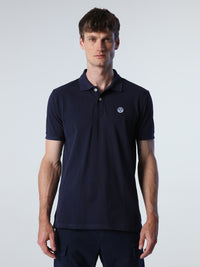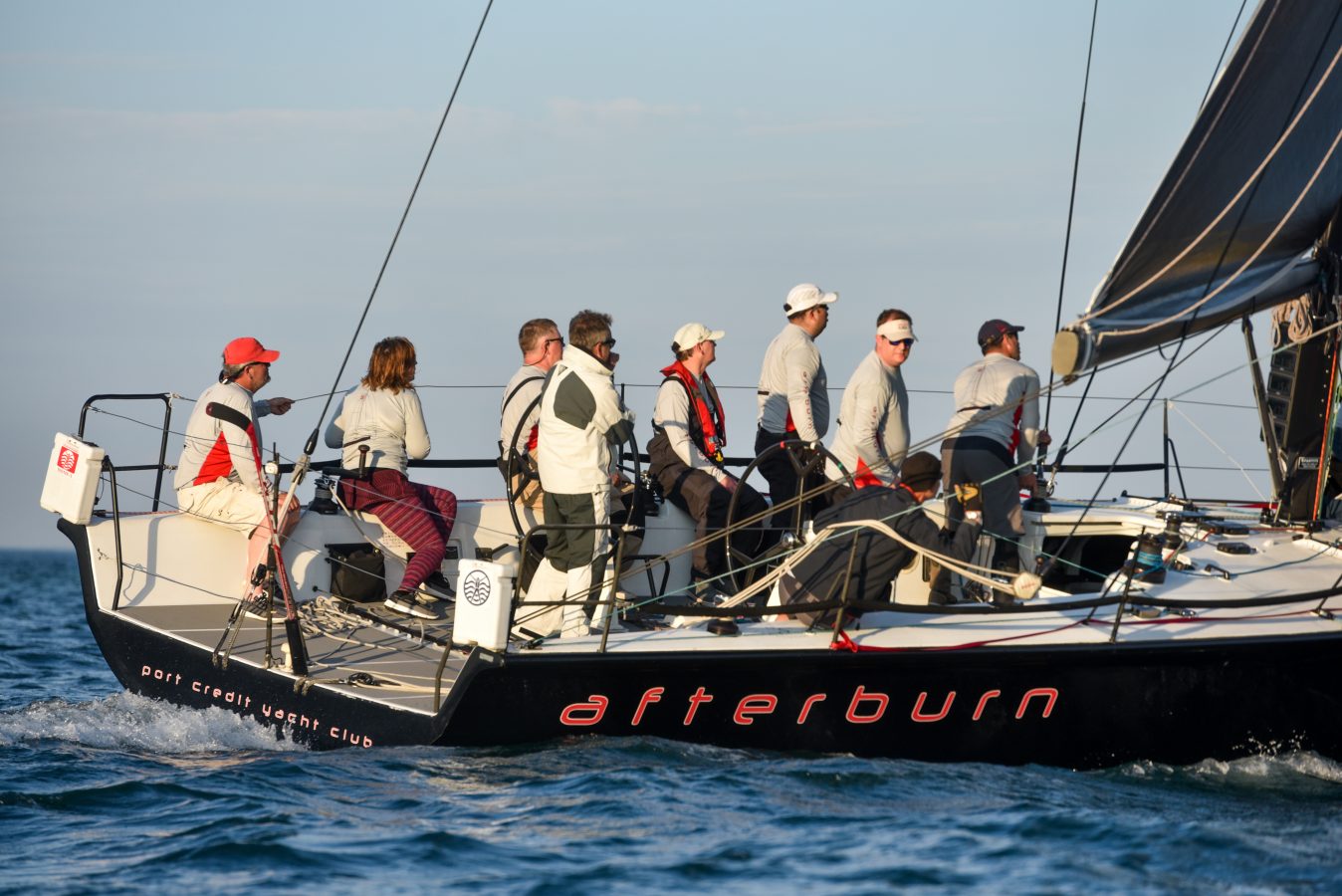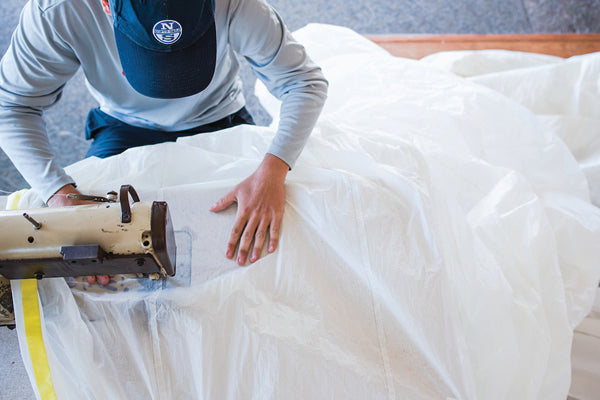AFTERBURN WINS 300NM WITH NORTH SAILS 3Di
From Light Air To Match Racing, North Powers Lake Ontario 300 Challenge Winners

What was the mindset of the crew going into the race?
The team was excited for the LO300, it is always a challenging race and this is typically the highlight of our racing season.
Although the race was shaping up to be a longer race than previous years, our routing software was predicting we would finish between late morning and early evening on Monday. The good news for us was that we would not be facing a third night on the lake, just a slightly longer Monday than usual, since we would typically aim to finish by sunrise on Monday.
The team was positive and we felt well prepared, we had sailed a 65 mile tune up race the previous weekend which had allowed us to test and resolve some rigging issues and also let us fine tune our electronics displays for the data we needed available on deck in the LO300.
How did the game plan change due to the light air?
We made the decision to go with a smaller crew of 7 instead of our typical crew of 10. This saved us about 600lbs. in crew & gear weight; had a crew where each member could perform most of the positions on the boat. We made sure all extra gear was removed from the boat to keep weight down. We hauled the boat and cleaned the bottom several days prior to the race, we also swam in water to clean boat bottom, keel and rudder two hours prior to our start.
We went with a 30 minute helm schedule in order to keep our drivers fresh and focused in the light and challenging wind conditions. We rotated through five drivers which meant you wanted to make the most of your 30 minutes on the helm and you were itching to get back on when you came back up in the rotation.
Forecast was for a bubble of light air to form around Toronto in early afternoon, but there was to be better wind pressure to the east of Toronto although it was to move east down the lake as the day and evening progressed. Based on this forecast our aim was to get south of Toronto to avoid as much of the light air surrounding the city as possible and try to hook into the pressure to the east of the city, then work the boat as hard as possible to stay in that breeze all the way to Ford Shoal.
What role did sail changes play in your victory?
In the Susan Hood 75 mile long distance race earlier this year we identified the need to be able to execute spinnaker peels from our furling Code Zero to our Asymmetrical spinnakers (A1.5, A2 and A4), but at the time our Soto 40 was not setup to do this. Prior to the LO300 we rigged a second tack line and a second set of spinnaker sheets specifically for our furling Code 0 to allow us to perform spinnaker peels.
On the 130-mile second leg from the Humberview Mark to Ford Shoal our ability to perform these peels was key to our success on this leg and allowed us to stay with a breeze that was receding down the leg into Ford Shoal. It seemed like much of the race we were sailing at a true wind angle of 120 degrees, which in light winds of 4 to 10 knots is the cross over point from the Code 0 to the A1.5. On that leg we performed approximately 8 spinnaker peels in order to always have the best sail up for changing wind strength and angle and to keep the boat moving with the receding breeze.
How was this race a true test for your crew and sails?
The reality is that the Soto 40 is a grand prix level race boat and we are a crew of amateur sailors trying to figure out how to make the boat go fast and we are certainly having lots of fun as we learn.
Our boats strong point is off the wind when we have the spinnakers up, which was the first half of this race and we were able to establish a lead, the second half of the race coming back up the lake and with more upwind sailing was going to be our biggest test. We had boats with larger sail area and longer waterlines chasing us upwind on our return up the lake.
"To improve our Soto 40’s upwind performance we had added a new 3Di mainsail this season and this sail would be important, especially with the wind dead on the nose on the 40 mile stretch coming out of Main Duck Island to Point Petre at the west end of Prince Edward County. The main performed brilliantly, it had great shape and our main trimmers were able to keep the boat powered up along this upwind section. Learning the boat over the past two seasons the setup of the square top main has proved to be our biggest challenge."
In sailing with a small crew, everyone had to shift through most positions from helm, to sail trim, to tactics and navigation. One positive that came from this constant yet shifting involvement was that although the race was long all of our crew remained constantly engaged in the race.
Take us through the final leg when you were neck and neck with Esprit de Corps IV?
Not to make this out to be a completely light air LO300. Afterburn and the Volvo 60
Esprit de Corp IV were side by side (about 300m apart) and 12 miles out from the finish in Port Credit, we had been sailing with Code Zero’s trying to squeeze out speed from the 3 to 5 knots of patching Southern breeze that was flowing through the middle of the lake at midday. The wind started to back and both boats switched to asymmetrical spinnakers, the wind backed further and both boats gybed to a course heading to the finish at PCYC, the wind then rapidly built, within minutes it had gone from a light air drifter to a 30 to 35 knot blow. The Soto 40 quickly responded to the new breeze and accelerated to 20 knots with the puffs, and with only a few crew to hike we pushed the bow down to TWA of 158 degrees to help flatten out the boat. Because the breeze had built so quickly the lake was still flat water, we were blasting along keeping pace with the Volvo 60, both boats in a side by side drag race.
"For over 10 minutes we had sustained boat speed over 20 knots with a top speed of 25.58 knots, the Volvo topped out over 26 knots. This was a new top speed for us on the Soto 40."
After the initial excitement of the ride had settled in, we were faced with the realty that the new breeze had backed even further to the NE and we were now rapidly sailing towards Hamilton, 20 miles to the west of the finish. As a crew we quickly ran through our takedown procedure, in the next lull we doused the spinnaker, hoisted the jib and brought the bow up for a close reach sail for the final ten miles to the finish.
How has your performance improved compared to last year? What would you say are the contributing factors?
This is our third season with the Soto 40 and it has been a continual development process since acquiring the boat. I would say within the last month leading up to the race we finally began to feel that we had gotten to a solid baseline with the boat, its setup and its equipment.
This year we are finally focused on sailing the boat and working to make it go fast. We are getting much closer to our target speeds and are better able to fine tune the boat setup and gauge improvements. Our upwind sailing has seen the biggest improvements over last year, and that all starts with a new inventory of Jibs (J1, J2, J4) that were added at the start of last season and the new 3Di Main that we added this season.
"The new 3Di sails have great shape and our trimmers are better able to adjust and match the sail profiles between the main and jib for improved speed and performance. Upgrading the electronics and properly calibrating our boat speed and wind data now gives us the ability to sail to our target speeds and angles. Subsequently our crew has now gotten more time on the boat to work on trimming these new sails and learning which setups are fast in the various conditions."
As mentioned earlier our sail handling with the addition of furling for our Code 0 and FRO and the second tack line to allow us to perform spinnaker peels also allowed for better downwind performance.















